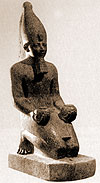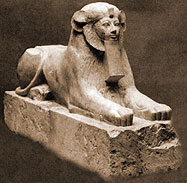 |
The chief
queen of Tuthmosis II, who declared herself King of Egypt.
Before he died, the King
and husband of Hatshepsut, Tuthmosis II chose his son Tuthmosis
as his heir (the son of an harem wife). However when Tuthmosis
II died, the new king Tuthmosis III was still quite young and
so the Queen Hatshepsut stood as regent - during this period
she still used the same titles as she used when the wife of Tuthmosis
II (King's
Daughter, King's Sister, God's Wife and King's Great Wife).
Year 2 and the change
of power.
Tuthmosis III and his
regent Hatshepsut ruled jointly for only a short time - in Year
2 of Tuthmosis III's reign, Hatshepsut declared herself Pharaoh.
In order to justify her new position, she assumed the titles
and clothes of a male king. Hatshepsut could not have made this
leap for power without help, she had the backing of key members
of her court - including Hapseneb - as well as the High Priests
of Amun. An inscription at the time details this change in power:
'Came
forth the king of the gods, Amun-Re, from his temple, saying:
"Welcome, my sweet daughter, my favourite, the King of Upper
and Lower Egypt, Maatkare, Hatshepsut. Thou art the king, taking
possession of the Two Lands".
Hatshepsut still needed
to support her claim to rule as King - on the walls of her funerary
temple at Deir el-Bahri scenes show her divine birth, her father
being the King of gods, Amun-Re (identified as Tuthmosis I).
These scenes show Amun-Re on his way to see Ahmose (mother of
Hatshepsut):
'He made
his form like the majesty of this husband, the king Aakheperure
[Tuthmosis I]. He found her [Ahmose] as she slept, in the beauty
of the palace. She waked at the fragrance of the god, which she
smelled in the presence of his majesty. He went to her immediately...'
|
Hatshepsut also claimed
to have been crowned king of Egypt while her father, Tuthmosis
I, was still alive - showing that she was his chosen heir. To
confirm her kingship, Hatshepsut would also be depicted as a
man, or wearing a King's headress with a woman's body - sometimes
she would be referred to as 'he', or the feminine ending to the
word for 'majesty' would be added.
Foreign
policy
Although through the
successes of Ahmose I, Amenhotep I and Tuthmosis I had increased
Egypt's power and wealth dramatically, Hatshepsut chose not to
pursue a military policy (there is one reference to a minor raid
in Nubia during her reign), instead she concentrated on the internal
affairs of Egypt and trading expeditions. These trading expeditions
included : Byblos for timber, Sinai for turquoise and to the
mysterious land of Punt for incense (the expedition to Punt was
documented on her mortuary temple at Deir el-Bahri).
Building
projects of Hatshepsut.
Hatshepsut had an active
building programme, she also restored the sanctuaries of Middle
Egypt which had fallen into dis-repair since the Hyksos Period.
At Karnak she built to honour Amun-Re ('Her Majesty did this because
she loved her father Amun so much, more than all other gods....
I have done this from a loving heart for my father Amun'), here she raised 2 obelisks
(one collaspsed in antiquity, both were ornamented in fine gold)
and begun the Temple of Mut, (But her greatest building project
was her Mortuary temple at Deir el-Bahri).
|
Inscriptions
from the surviving obelisk of Hatshepsut:
|
Officials
of Hatshepsut:
Senenmut - the Royal Steward
Hapuseneb (related to the royal family
by his mother Ahhotep), he was the High Priest of Amun at Thebes,
and supervised many royal building projects.
Nehsy, Chancellor (led the expedition
to Punt in Year 9).
Inebni, Viceroy of Kush
Thuthmose, Treasurer (TT110)
Amenhotep, Chief Steward (TT73)
Useramun, vizier from Year 5 onwards.
Djehuty, overseer of the Treasury, nomarch
in Herwer (middle Egypt), overseer of Priests of Thoth in Hermopolis
(inscriptions in his tomb at Dra Abu el-Naga tell of the numerous
building works he supervised on behalf of Hatshepsut).
Puyemra, second priest of Amun
The
end of Hatshepsut
Towards the end of her reign, the Asiatic peoples staged a revolt
centered on the city of Kadesh, Tuthmosis III himself led the
Egyptian to quash this uprising and Hatshepsut disappeared. Tuthmosis
III was finally able to claim his rightful place as King of Egypt,
now came vengeance - all images of Hatshepsut were attacked;
statues, reliefs and shrines all were defaced.
Scene
from the temple of Amun at Thebes, showing the hacked-out image
of Hatshepsut

What
happened to Hatshepsut's mummy?
The location of her tomb is known (KV20),
and her sarcophagus (as well as that of Tuthmosis
I) found inside, her mummy has never been positively identified,
there have been some possibilities found:
1. The 'elder woman' found in the
cache of Amenhotep II has been identified by some as belonging
to Hatshepsut.
2. An unidentified mummy found in the tomb of Hatshepsut's nurse
- Sitre In (KV60). This tomb was discovered by Howard Carter in
1903, inside there were two female mummies found inside; one
was in a coffin inscribed for Sitre In (taken to the Egyptian Museum in 1906),
the second mummy (in which the left arm of the mummy crosses
the breast and the right lies along the side in a possible 'royal
position' could be that of Hatshepsut (removed in late 1980's).
3. An unidentified mummy
as part of the cache of mummies found in TT320.
Hatshepsut's canopic chest was discovered in the cache (inside
the canopic chest were remains of her liver), it is possible
that one of the two unidentified female mummies (which had been
stripped of all wrappings and without a coffin or sarcophagus)
may be that of Hatshepsut.
Hatshepsut's original tomb from when she was Queen of Tuthmosis II was discovered by Howard Carter in 1916, her original sarcophagus was found there - CLICK HERE for more details
|










